The ADATA XPG SX8200 & GAMMIX S11 NVMe SSD Review: High Performance At All Sizes
by Billy Tallis on July 25, 2018 11:00 AM ESTAnandTech Storage Bench - The Destroyer
The Destroyer is an extremely long test replicating the access patterns of very IO-intensive desktop usage. A detailed breakdown can be found in this article. Like real-world usage, the drives do get the occasional break that allows for some background garbage collection and flushing caches, but those idle times are limited to 25ms so that it doesn't take all week to run the test. These AnandTech Storage Bench (ATSB) tests do not involve running the actual applications that generated the workloads, so the scores are relatively insensitive to changes in CPU performance and RAM from our new testbed, but the jump to a newer version of Windows and the newer storage drivers can have an impact.
We quantify performance on this test by reporting the drive's average data throughput, the average latency of the I/O operations, and the total energy used by the drive over the course of the test.
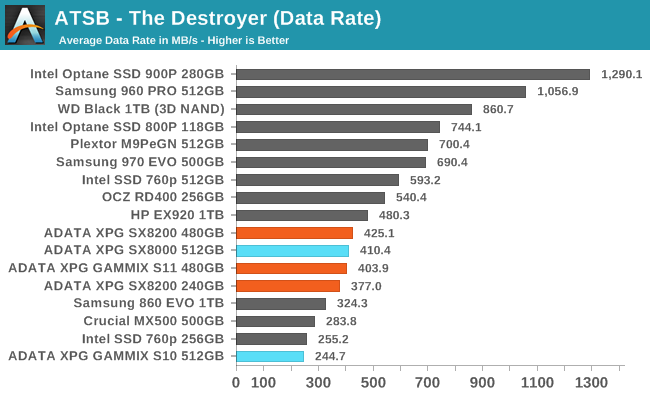
The performance of the ADATA drives on The Destroyer is about as expected given how the other SM2262 drives behave: The average data rates are significantly lower than most of the other recent high-end SSDs. The SX8200 and GAMMIX S11 with 64L 3D TLC and a newer controller perform about as well as the older SX8000 with 32L MLC and the slower SM2260 controller, while the older TLC-based GAMMIX S10 sits at the bottom of the chart. It is interesting that the Intel 760p with very similar hardware shows much greater variation in performance between capacities than the SX8200. Whatever customizations Intel has made to the SM2262 platform are helping their 512GB model but hurting the 256GB model.
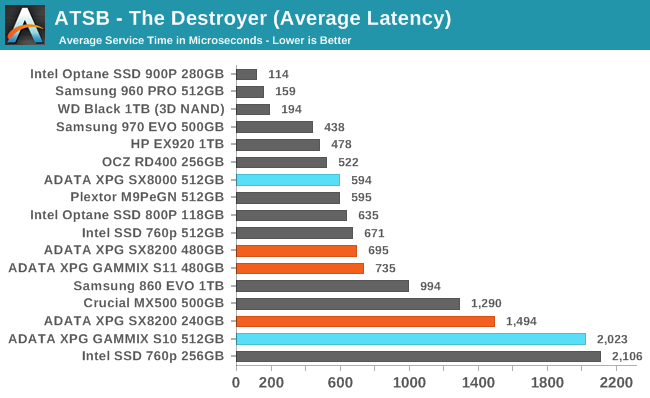
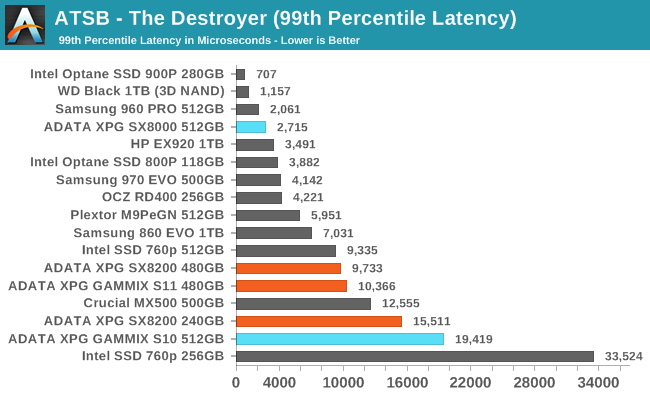
The SX8200 and GAMMIX S11 can't match the latency of the MLC-based SX8000 on The Destroyer, with a small disadvantage in average latency and much worse 99th percentile latency. Compared to the previous-generation TLC drive, things are greatly improved to the point that the 240GB SX8200 has lower latency than the 512GB GAMMIX S10.
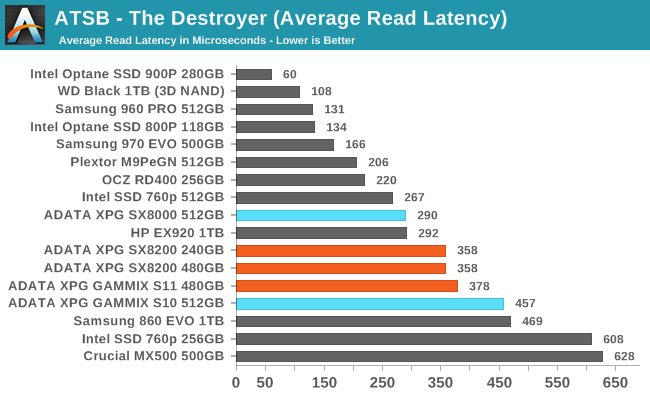
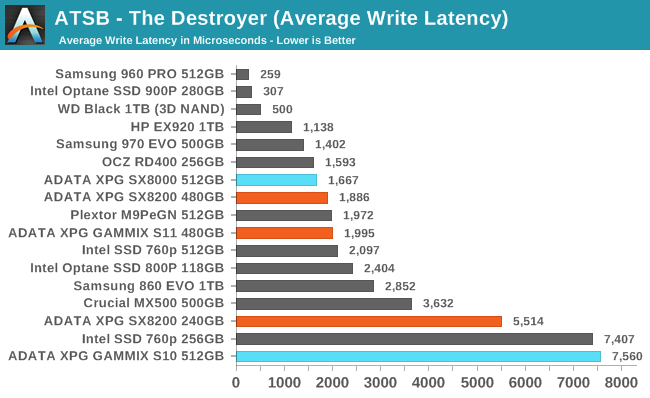
Differences in drive capacity seem to have a much bigger effect on the SX8200's average write latency than the average read latency. However, it's on the read side that the latency of the SX8200 stands out as clearly worse than other current competitors like the Samsung 970 EVO. The poor write latency of the TLC-based GAMMIX S10 has been thoroughly addressed by the new drives, with a factor of four improvement.
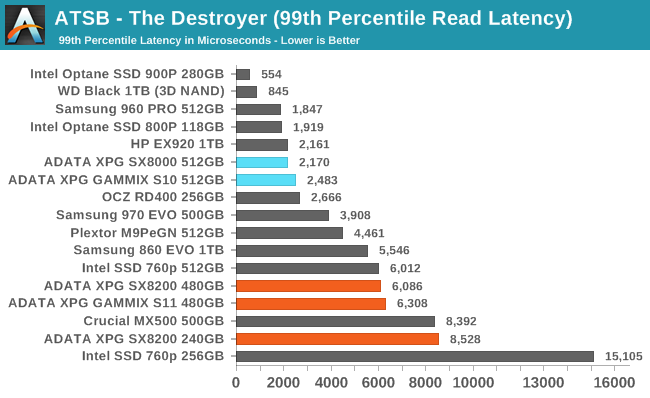
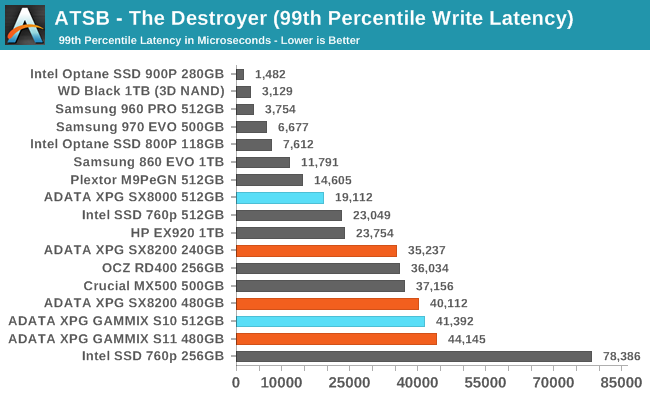
The older SM2260 SSDs with MLC or TLC have much better 99th percentile read latencies than the newer ADATA drives with the SM2262 controller. Average latency for the TLC-based drives is vastly better with the newer generation, but some consistency has been sacrificed. The 99th percentile write latency hasn't changed much, and the MLC-based SX8000 still has a clear advantage there despite using the older controller and NAND.
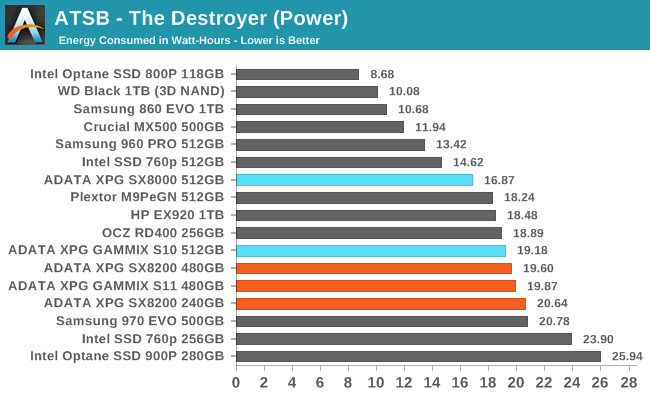
The SX8200 and GAMMIX S11 use a bit more energy than their predecessors to complete The Destroyer, but this isn't too surprising–it's often necessary to sacrifice some efficiency to get better performance, and The Destroyer is quite a bit more intense than the workloads that the newer ADATA drives are optimized for.










19 Comments
View All Comments
stanleyipkiss - Wednesday, July 25, 2018 - link
I.... I... I want one!superunknown98 - Wednesday, July 25, 2018 - link
Yeah, what is the deal with the Intel 760p? is there a firmware that fixes it?Billy Tallis - Wednesday, July 25, 2018 - link
There hasn't been a firmware update for the 760p yet: https://www.intel.com/content/www/us/en/support/ar...Rick F - Wednesday, July 25, 2018 - link
Thank you. This helped me avoid two different mistakes buying an M.2 for an Asrock x370 Taichi, All of the nonworking Adata's are on the QVL, along with the 8200 that works.The 8200 read speed is comparable to Samsung, but the write speed is about half as fast as Samsung. For the cost the 8200 is much more affordable for PCIe 3.0 nvme 1.3.
So now what to do...a few years ago, B+M M.2 Sata was pretty standard. PCIe was Samsung only and cost too much. Now M.2 is in transition and not so easy.
Think I'll sleep on it, and choose a lot of Sata space, or M.2 with a controller that hasn't gone through the wear leveling of an ssd yet...Again thanks for the heads up.
CheapSushi - Wednesday, July 25, 2018 - link
This just makes me want the Intel 900P even more. I'm hoping to have Optane drives for performance, cache and main programs & OS and just use QLC NAND drives for storage.Amandtec - Thursday, July 26, 2018 - link
How about run Fuzedrive with 2GB ramdrive, 32GB Optane, 256QLC and 4+TB HDD. Everything should kind of work out quite nicely (unless you mostly access very large files only once).deil - Thursday, July 26, 2018 - link
that's my plan, I just want to use 58 GB optane drive, and maybe 512GB mv500 SSD.Death666Angel - Thursday, July 26, 2018 - link
I guess some people, including me, want to KISS regarding their PC storage tiers. How are the failure states when it comes to the Fuzedrive implementation? Is it all just cached on the faster stuff and backed up on the normal HDD, so a drive failure "in front" isn't catastrophic? I'm personally super fine with my M.2 NVME SSD (960 Evo on sale) as an OS drive and a spinning platter for other stuff on my main PC (soon to be replaced with a M.2 SATA / NVME SSD depending on motherboard upgrades) and a whole bunch of HDDs in my file server. I don't see a scenario where I need optane like performance just yet. And for the Fuzedrive thing, see above, plus I don't need simple documents or pictures loading faster, they load just fine for my taste. :) Avoids all the potential headaches of another layer of software between me an my data.DigitalFreak - Thursday, July 26, 2018 - link
With FuzeDrive, if either drive fails, you lose all data. Similar to RAID 0.Samus - Friday, July 27, 2018 - link
Backblaze is $50 a year.